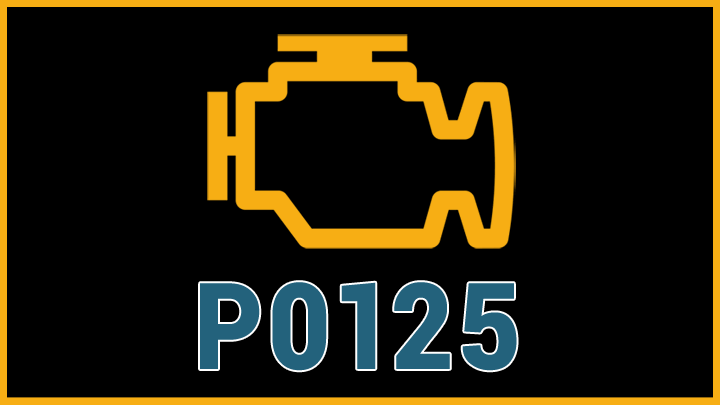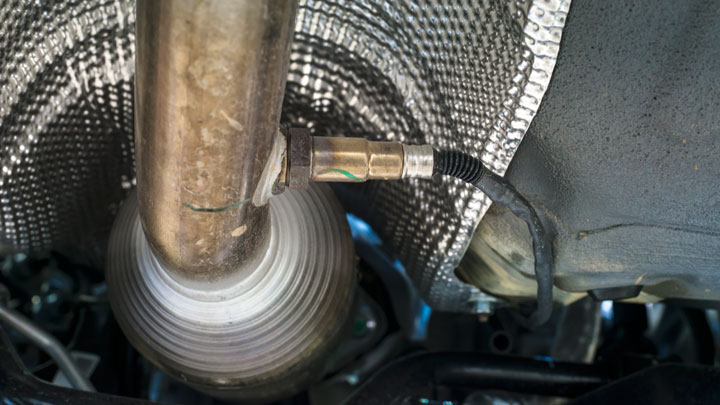P0125 Code (Symptoms, Causes and How to Fix)
Few things can be more frustrating than having the dreaded Check Engine Light (CEL) illuminate in your dash. While it may turn out to be minor in nature, don’t want to take any chances and get the code read (via an OBD2 scanner or having a shop do it).
The fact that you’re on this page likely means you’ve gotten a P0125 code. Keep reading to learn what code P0125 means, problems it can cause, reasons it can show up, and how to fix the problem.

What Does Code P0125 Mean?
The above is the most common description for a P0125 code. Let’s define these and related terms.
- Insufficient Coolant Temperature – When started from a cold condition your car’s engine coolant will increase in temperature. A coolant temperature sensor enables the PCM (Powertrain Control Module) to monitor this temperature continually. Insufficient Coolant Temperature is the condition where the coolant does not increase beyond 160° to 170° F, a predefined minimum operating temperature range.
- Open Loop – This is the term applicable to the engine start and warm-up mode. In this mode the adjusts the fuel mixture to a rich condition (high fuel to air ratio) enabling quick engine startup and smooth cold engine operation. This condition causes a relatively high level of unburned fuel and carbon monoxide to exit the engine and head for the catalytic converter(s) and out the exhaust system.
- Closed Loop – This is the term applicable to run mode when the engine is warmed up (above 170° F). In this mode the PCM will adjust the fuel to air ratio continually based on several variables including coolant temperature, inlet air temperature, engine speed and the demand placed upon it by the driver. In closed loop the fuel to air mixture will be significantly leaner (less fuel) than that of the open loop condition.
See Also: Code P0116, Code P0117, Code P0118, Code P0128
Potential Problems

The OBD2 system sets a P0125 code when the engine during the warm-up process fails to reach the 160° to 170° Fahrenheit range within 15 minutes. When this happens, the following adverse problems can occur.
#1 – Incomplete Combustion
This condition delivers an overly fuel rich mixture to the catalytic converter. This can result in an overheat condition for this costly device eventually causing permanent damage.
Incomplete combustion also enables fuel and fuel byproducts to escape past the piston rings into the crankcase. These vapors and fluids will blend with and thin the engine oil degrading its lubricating properties and increasing its acidity. Both conditions can cause excessive wear to moving parts thus degrading engine life.
#2 – Damage to Oxygen Sensors
Excessive heat may cause harm to the O2 sensor(s). These sensors’ performance in controlling fuel to air mixture will then be degraded.
#3 – Degraded Fuel Economy
Excess fuel consumption will occur, increasing your costs at the pump.
#4 – Low Engine Temperature
This may lead to sludge accumulation in the engine which could block oil passages and degrade lubrication effectiveness. Severe damage to the engine could result.
Symptoms of Code P0125
When this code is set you may notice any or all of the following symptoms:
- The engine temperature gauge in the instrument panel may not rise to normal operating temperature.
- The climate control system may not produce sufficient heat to warm the car.
- The automatic transmission may not shift to the highest gear when you’re traveling at a continuous speed.
- Fuel economy will degrade.
- Though rare, in some cases the engine may increase in temperature above the normal range. Overheating may result.
Causes of Code P0125

The following conditions or malfunctions may result in setting this code. For each cause or condition, corrective action can be accomplished either by a skilled DIYer or will require a competent repair technician.
#1 – Faulty Thermostat
This is the most common cause for Code P0125 to be set. The thermostat is opening at too low a temperature or it has failed in the open position.
How to Fix
Replacement of a faulty thermostat is well within the capability of a skilled DIYer.
#2 – Inoperative Coolant Temperature Sensor
The sensor is not sending the necessary temperature signals to the PCM. This could be caused by either a defective sensor or by disconnected or damaged sensor wiring.
How to Fix
A DIYer in general will not be able to diagnose this fault. A skilled repair technician will be needed for corrective action.
#3 – Low Coolant Level
Coolant may be too low to circulate around the temperature sensor. Coolant loss has caused this problem.
How to Fix
This can be observed and corrected by a DIYer. However such a corrective action may provide only temporary benefit since the leakage causing the problem must be assessed and repaired. A skilled repair technician will be required for this.
#4 – Engine Cooling Fan(s) May Run Continuously
Excessive cooling of the antifreeze in the radiator may result.
How to Fix
A skilled repair technician will be needed for corrective action.
#5 – PCM Malfunction
A faulty Powertrain Control Module would not properly interpret the signal from the temperature sensor.
How to Fix
A skilled repair technician will be needed for corrective action.
#6 – Starting the Engine in Exceptionally Cold Outdoor Conditions
Example, a cold start after the car has sat out overnight in temperatures well below 0° Fahrenheit. In this situation the CEL would be expected to extinguish following several warm start cycles.
How to Fix
This is an environmental condition. A possible corrective action would be to avoid allowing the car once started to sit and warm up. Instead, start the engine, allow a minute or two for warmup, then head out for your destination.
Driving the car loads the engine far more than just sitting at idle. This can help get the coolant temperature up to temperature more quickly.
Have an electrically-powered engine heater installed to keep the engine warm overnight in cold weather. Engine warmup after starting will occur more quickly in winter if the engine is pre-warmed in this fashion.
Is Code P0125 Serious?
Yes, this code is serious. Here’s why:
For maximum operating efficiency and engine longevity, the engine operating temperature must be in a range at or above 200 degrees F. Combustion and lubricating processes function best at these temperatures.
Specific issues and consequences with the engine running at low coolant temperatures are described above. Most of these issues can lead to the need for costly repairs.
Any CEL illumination event necessitates expeditious diagnosis and corrective action to minimize risk of damage to your automobile’s engine and/or other systems.
Related Information for Code P0125
Some late 1990’s Toyotas may set Code P0125 when an oxygen sensor failure occurs.
- DIY Car Repair Tools – Floor Jack and Jack Stands - Dec 12, 2023
- DIY Car Repair Tools – Socket (Ratchet) Wrench - Nov 9, 2023
- DIY Car Repair Tools – Torque Wrench - Apr 20, 2023
